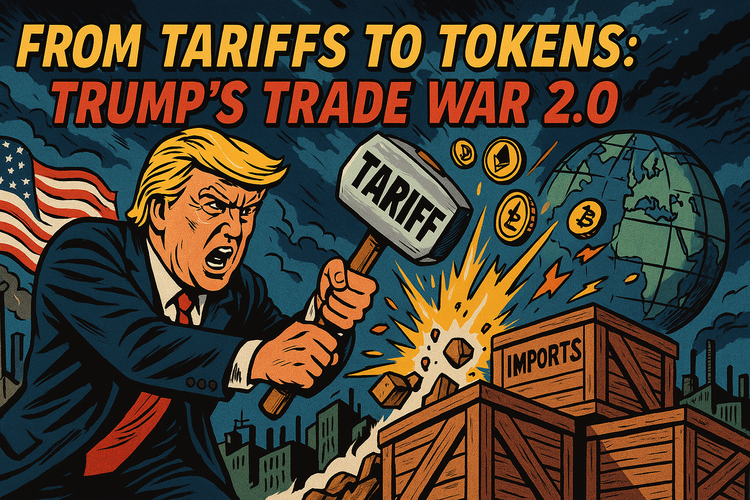Easy Monetary Policy: The Rocket Fuel that Propeled Cryptocurrency's Meteoric Rise?

In the contemporary financial landscape, there's one phenomenon that refuses to be ignored: the seemingly unstoppable rise of cryptocurrency. This digital asset class, led by Bitcoin, Ethereum, and a myriad of altcoins, is increasingly shaping the future of money. But what was the catalyst behind this explosive growth? Many points toward the role of easy monetary conditions. In this article, we'll delve into this relationship, exploring the fundamentals of easy monetary policy and how it fueled the ascent of cryptocurrencies.
What is Easy Monetary Policy?
Easy monetary policy, also known as expansionary monetary policy, is a strategy used by central banks to stimulate economic growth. This is typically achieved through two primary mechanisms: lowering interest rates and increasing the money supply. When interest rates are low, borrowing becomes more affordable, encouraging spending and investment. Similarly, an increased money supply — achieved through quantitative easing methods—means more money is in circulation, further encouraging economic activity.
Characteristics of Easy Monetary Conditions
To understand how this relates to cryptocurrencies, it's necessary to identify the key characteristics of easy monetary conditions:
1. Low-Interest Rates: Central banks reduce interest rates to stimulate borrowing and spending, fueling economic activity.
2. Increased Money Supply: Central banks often increase the supply of money through techniques like quantitative easing, pushing more capital into the economy.
3. Incentivized Investment: Lower returns on savings due to reduced interest rates encourage individuals and businesses to invest in higher-yield opportunities, including capital investments and the stock market.
4. Potential for Inflation: While stimulating economic growth, easy monetary policy can also lead to inflation. If the increase in money supply outpaces economic growth, it can result in an overall increase in prices.
5. Currency Depreciation: An increase in the money supply can lead to a fall in the value of the currency on the international market, as it dilutes the value of money.
The Rise of Cryptocurrencies in an Easy Monetary Environment
Cryptocurrencies were seen as attractive investment options in an era of easy monetary conditions. Here's why:
High Potential Returns: High-yield investments had become more appealing as low-interest rates offered minimal returns on traditional savings. Cryptocurrencies, despite their volatility, had shown potential for high returns, drawing investors looking for assets that could outpace inflation.
Decentralization: The decentralized nature of cryptocurrencies offered a level of security and transparency that was not possible with traditional currencies. This was particularly appealing in an environment where trust in central banks might have been eroding due to policies that could devalue the traditional currency.
Increased Liquidity: As central banks pumped more money into the economy, investors had more capital at their disposal. Some of this extra liquidity found its way into the cryptocurrency market, pushing prices up.
Cryptocurrency in Easy Monetary Conditions
As central banks around the world embraced easy monetary policies in response to economic downturns and crises, the stage was set for the meteoric rise of cryptocurrencies. While the volatile nature of these digital assets introduced an element of risk, their potential as high-yield investments and hedges against inflation under easy monetary conditions made them an increasingly popular choice among investors. Therefore, understanding the dynamics between cryptocurrency and easy monetary conditions is crucial for both traditional and digital asset investors.
Conclusion
In conclusion, the easy monetary environment created by central banks worldwide inadvertently became a catalyst for the meteoric rise of cryptocurrencies. The conditions of low interest rates and increased money supply played into the strengths of these digital assets, highlighting their potential as inflation hedges and high-yield investments.
However, like all investment opportunities, cryptocurrencies come with their own set of risks. Their inherent volatility and the regulatory uncertainties surrounding them were factors that potential investors should not have overlooked. Regardless, with easy monetary policies, the allure of cryptocurrencies has grown.
Disclaimer
*The information and analysis provided in this article are intended for educational and informational purposes only and should not be considered as financial, investment, or professional advice. While our team strives to ensure the accuracy and reliability of the content, we make no representations or warranties of any kind, express or implied, about the completeness, accuracy, reliability, suitability, or availability of the information presented.
The content within this article may include opinions and forward-looking statements that involve risks and uncertainties. The blockchain and cryptocurrency markets are highly volatile, and past performance is not indicative of future results. Any reliance you place on the information presented is strictly at your own risk. Before making any investment decisions, we highly recommend consulting with a qualified financial advisor or conducting your own thorough research.
By accessing and using the information provided in this article, you acknowledge and agree that neither the authors, publishers, nor any other party involved in the creation or delivery of the content shall be held liable for any direct, indirect, incidental, consequential, or punitive damages, including but not limited to loss of profits, goodwill, or data, arising out of your use or inability to use the information provided or any actions you take based on the information contained within this section.*





